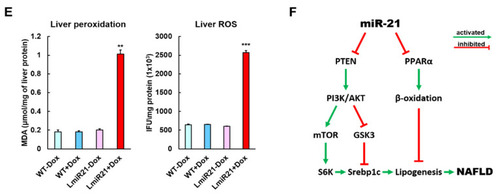
MiR-21 targets ptenb and pparaa levels in hepatocytes, which leads to nonalcoholic fatty liver disease (NAFLD) progression. (A) Schematic alignment between the mature miR-21 seed sequence (red) and (1) ptenb, (2) pparaa mRNA target sequence (blue) at the 3′-UTR. Perfect matches are indicated by a line, and G:U pairs by a colon. (left). Whole mount in situ hybridization (ISH) assays demonstrate that miR-21 significantly represses in vivo expression of (1) ptenb and (2) pparaa mRNA in AmiR + Dox, compared to that in AmiR-Dox (right). Scale bar:1 mm. (B) MiR-21 expression in the livers of WT ± Dox and LmiR21 ± Dox at 4 mpf. mRNA expression levels of ptenb and pparaa mRNA liver of WT ± Dox and LmiR21 ± Dox at 4 mpf. (C) Western blot images (left) and quantitative data (right) of Ptenb, Pparaa and p-Akt in the livers of WT ± Dox and LmiR21 ± Dox at 4 mpf. (D) Increased expression of lipogenic genes in response to pten suppression was greater in LmiR21 + Dox than controls (n = 3). Decreased expression of genes involved in fatty acid β-oxidation in response to pparaa suppression was greater in LmiR21 + Dox than controls (n = 3). (E) Levels of hepatic oxidative stress, MDA, and H2O2 in hepatic mitochondria is also greater in LmiR21 + Dox than in the controls (n = 3). (F) Bilateral-factorial effects of miR-21 in NAFLD acceleration. Statistically significant differences from LmiR21 − Dox were denoted by * (p < 0.05), ** (p < 0.01) and *** (p < 0.001) for panels B–E.
|

